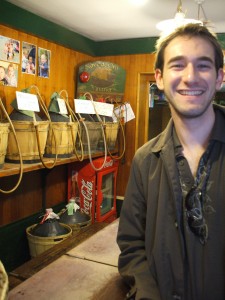Giro d’Italia – Central and Southern Italy
Marche (pronounced ‘mar-ke’), which faces the Adriatic sea to the east, is getting over its reputation as a mass-produced wine of unmentionable character. The key wine of the region, Verdicchio dei Castelli di Jesi DOC is known for it’s floral perfumed qualities when made well. The 2010 Casal Farneto ‘Crisio’ is medium straw in colour with notes of pear, Red Delicious apple, rose and lavender. It has a slight petillance which makes for a lighter-bodied mouthfeel.
Further south, lies Abruzzo and is known for the red grape Montepulciano. The wine is deeply coloured, medium-bodied and is mainly consumed young. An aged example, the 2008 Coste delle Plaie is still purpled in colour and has a mix of tart cherry, red berries, bell pepper and cinnamon spice. It still has good quantities of tannin and acid to keep it aging for a few more years. Otherwise, let it breathe or serve with red meat with tomato sauce.
Campania, the region that encompasses the towns of Naples, Pompeii and the idyllic Amalfi Coast is not as represented on our market compared to some the other regions. So a visit to a wine agency or LCBO/SAQ in an Italian neighbourhood is a good idea to source these wines. A particular white wine, Lacryma Christi (translates to ‘tears of Christ’) comes in red (rosso) and white (bianco) versions. The 2012 Mastroberardino Lacryma Christi del Vesuvio white is a light-bodied wine with scents of Muscat grape, peach and straw. There is also a light spritz to enliven the light acidity. This is a wine meant to be enjoyed young and can be had as an aperitivo.

Smiles, brimming from ear to ear. Taken at a wine shop in Venice. You can fill up any container you like, such as the water bottle I used. One litre of Cabernet franc for 2,30 € and it was the best-valued table wine I had on the trip.
Italy’s southern half is coming more fashionable in the wine scene with grapes such as Nero d’Avola, Aglianico, Primitivo and Gaglioppo making quite the splash. Primitivo, also known as Zinfandel is widely planted but is a principal grape of Puglia, Italy’s ‘heel’. The grape is known for its fruit forward character in North American wines but Italy’s version is more balanced. The 2011 Itynera Primitivo IGT Salento has delicate fruit notes of strawberry, red currant and pomegranate but is balanced with cedar, smoke and rosemary. The tannins are soft and the wine has a weighty mouthfeel and long finish.
Calabria makes up the rest of the ‘footprint’. Two well-known appellations are Ciro and Lamezia and grapes such as Gaglioppo, Greco Nero, and Nerello Cappuccio are often used such as in the 2011 Statti Lamezia DOC. This wine is more rustic with notes of musk, natural rubber, cocoa, toffee, pepper and a touch of dried strawberry. The tannin and acidity are best tamed with food so the flavours (both food and wine) really begin to shine.
Last but certainly not least to be discovered is Sicily which is the island to the south. The volcanic soils emanating from Mount Etna and the scorching summer heat make for intense red wines. One producer in particular that has popped up is Cusumano and their two wines can be had for around $10. Their 2010 Syrah IGT Sicilia is an easy-going mixed red berry, cherry, cooking spice and rosemary type profile. The length is rather short-lived and the mouthfeel is meant to be on the lighter-weight side. Compare this to the wine made of Sicily’s principal grape, 2011 Nero d’Avola IGT Sicilia, and you’ll discover its blackberry, figgy fruit ripeness that is more full-bodied, with a measure of acid and tannin to provide a well-balanced structure.
And so concludes our first tour through Italy, top to bottom – A dozen wines down and about a hundred or so more to go (give or take a couple dozen). Flights of wines within regions can easily be tasted for anyone wishing to get to know a certain area more intimately. Even more exciting is actually visiting the country and tasting the many house wines of the restaurants you visit. They will dispel the stereotypes you have about ordering house wine in Canadian restaurants as the Italian vini della casa have much to offer and can be had for a few euros for a whole litre.
What’s up, DOC?
The term Denominazione di Origine Controllata is Italy’s version of signifying a controlled appellation and is found on many Italian wine labels. Various criteria such as grape varietal, harvest yield, vine density, location and maturation (to name a few) are regulated and need to be followed to achieve this distinction. A higher tier, DOCG (‘G’ standing for ‘e Guarantita’) has been granted to only a few appellations. Should the winemaker want the flexibility and choose to venture outside of these restrictions, a title of Indicazione Geographica Tipica may be on the label.
Search
Recent Posts
- Рабочее Зеркало 1xbet На Сегодня официальному Сайт 1хбет
- Рабочее Зеркало 1xbet На Сегодня официальному Сайт 1хбет
- 1xbet Зеркало Рабочее 1xbet Официальный Сайт вход На Сегодня и 1хбет Казино
- 1xbet Зеркало Рабочее 1xbet Официальный Сайт вход На Сегодня и 1хбет Казино
- 1xbet Вход На официального Сайт Через рабочее Зеркало
